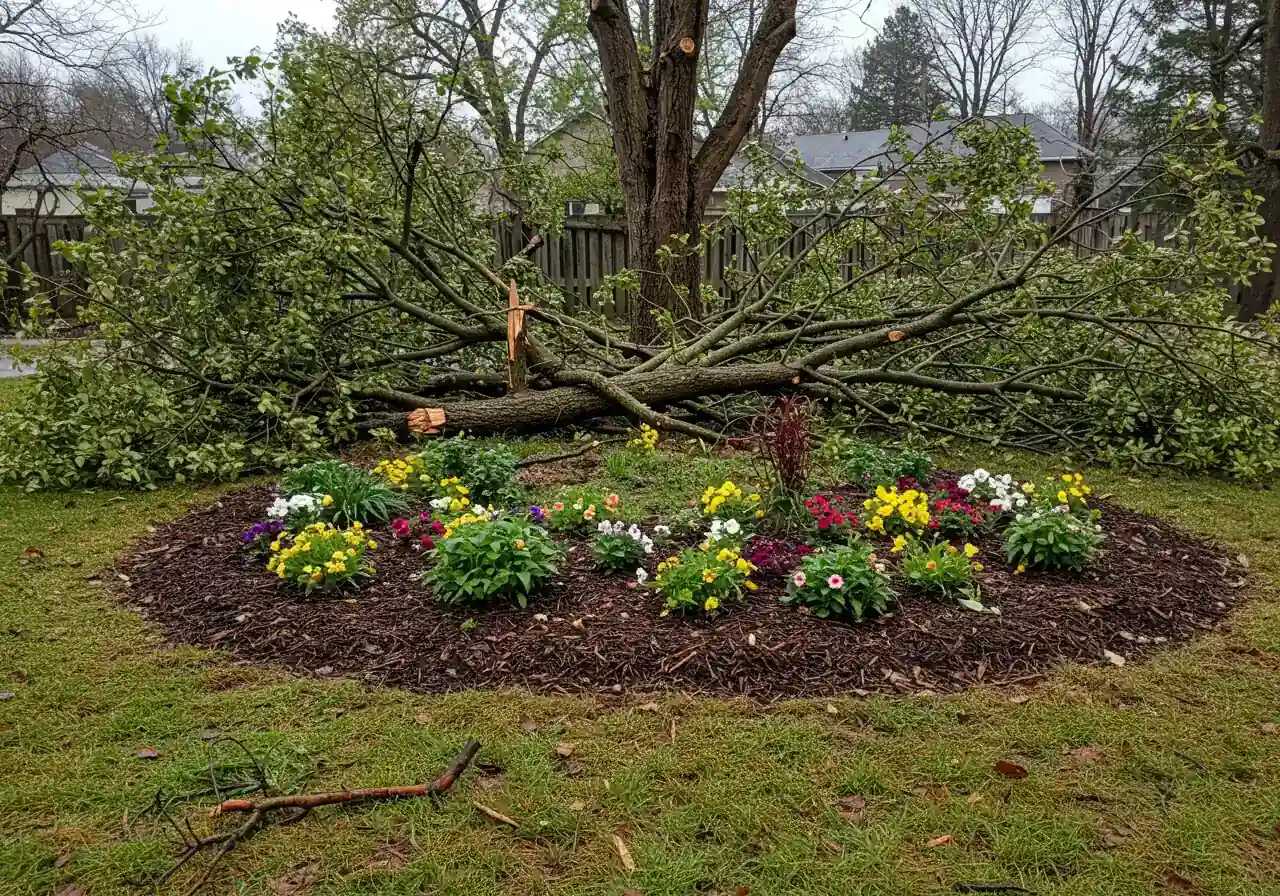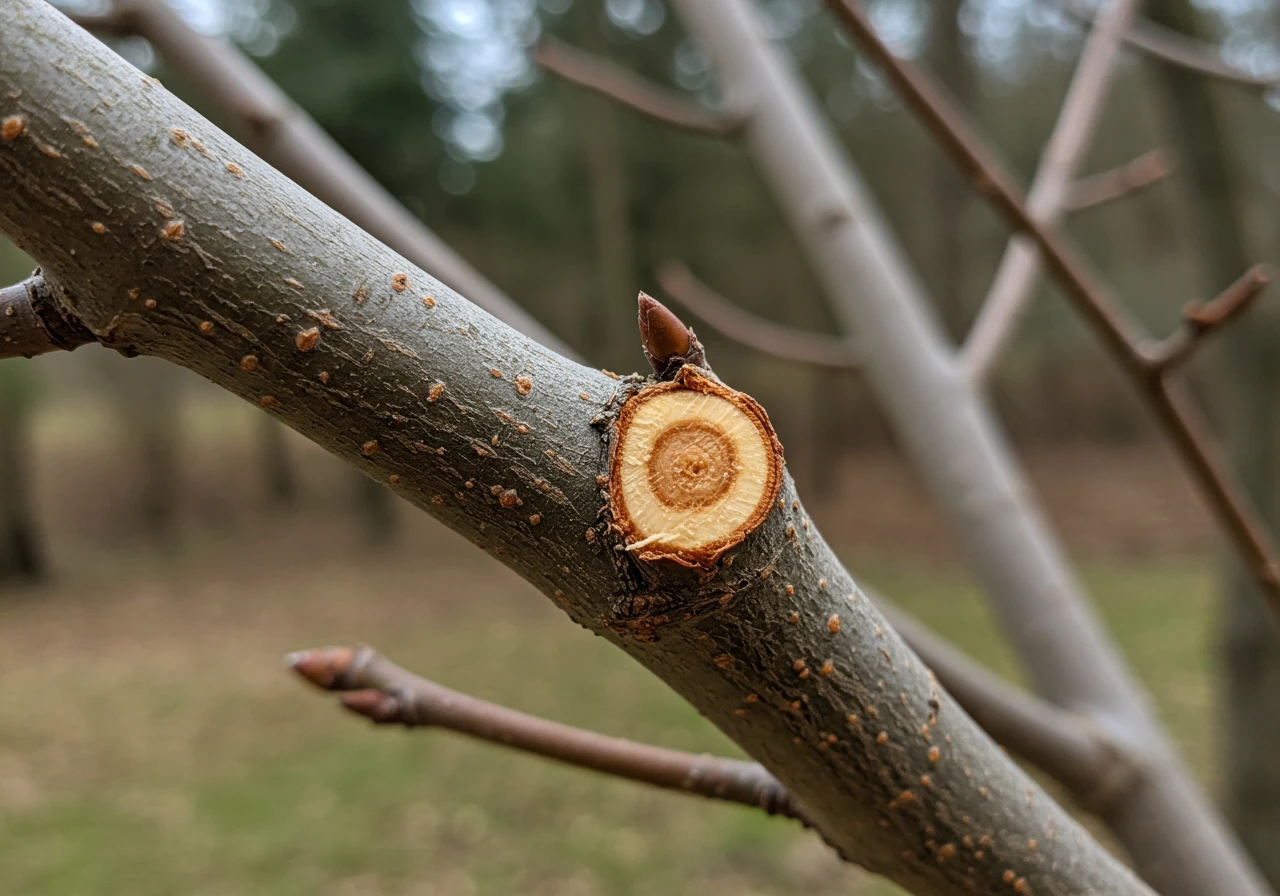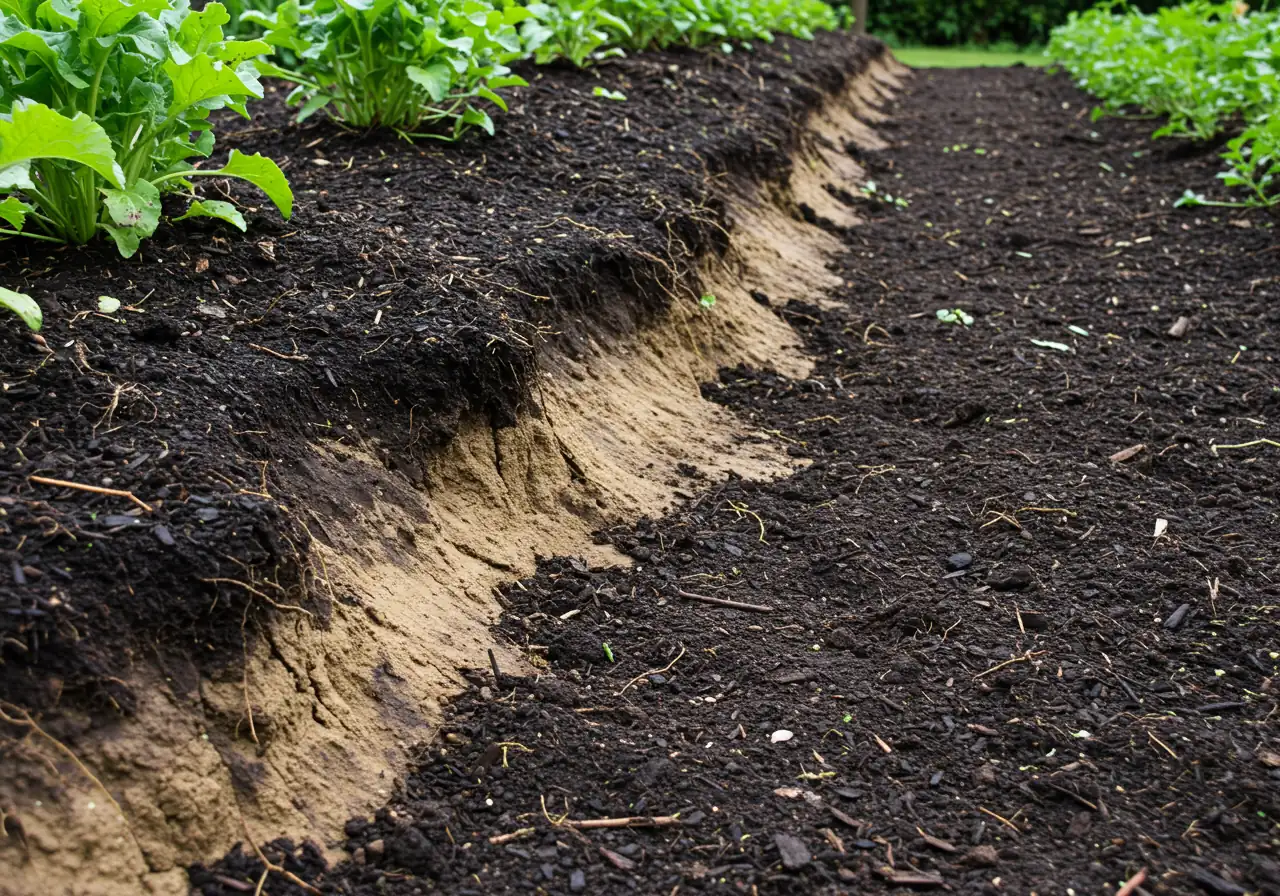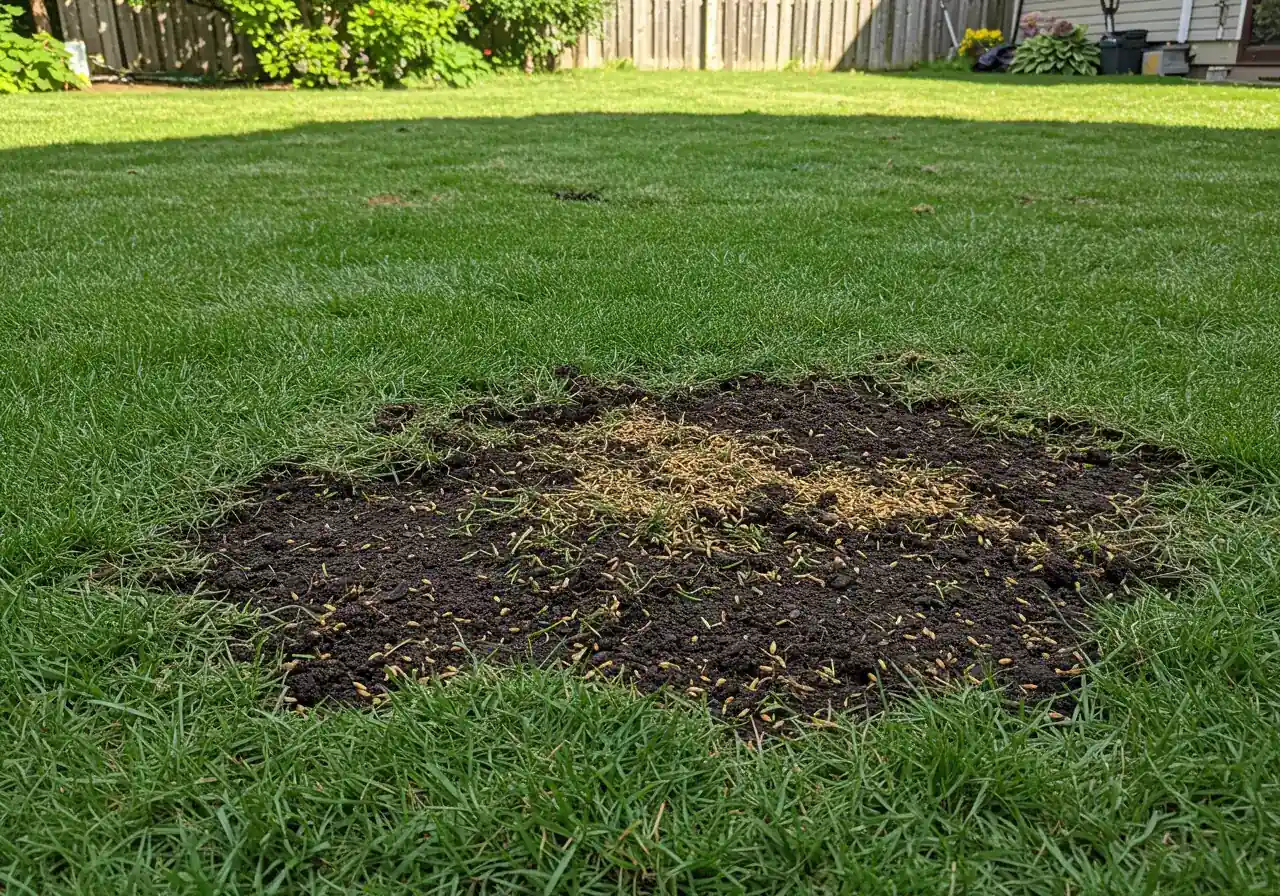Nepean Garden Recovery: Fix Storm Damage Before Winter
Quick Summary: Post-Storm Garden Fixes
- Assess Safely: Check for hazards like downed lines or unstable trees before entering the garden. Document damage with photos.
- Prioritize Repairs: Focus on safety issues, preventing further damage (fences, erosion), and critical plant health before winter. Aesthetics can wait.
- Handle Trees Carefully: Prune small damage safely; call certified arborists for large branches, leaning trees, or removal needs.
- Tend Shrubs & Soil: Prune broken shrub stems, replant uprooted perennials, replenish lost mulch, and address soil compaction/erosion.
- Rescue the Lawn: Clear debris, level patches, overseed bare spots, and apply winterizer fertilizer before the ground freezes.
- Act Before Frost: Aim to complete critical repairs before late September/early October when Ottawa's first frost typically arrives.
Need help restoring your Nepean garden after the storm? Let the pros handle it.
Request Your Free QuoteIntroduction: Uh Oh, Ottawa! Your Nepean Garden Took a Hit?
Well, hello there, fellow Ottawa gardeners! Especially those of you in Nepean, did that last wild storm leave your backyard looking a bit like it threw a party you weren't invited to? We know the feeling. One minute, you're admiring your lovely landscaping, maybe planning your fall garden prep, and the next – *whoosh* – branches are down, flowers are flattened, and your carefully tended veggie patch looks like it went through a blender.
Ottawa weather is famous for keeping us on our toes, isn't it? From sudden downpours rattling roofs in Barrhaven to those gusty winds that seem to aim *personally* for your prize-winning roses. Seeing storm damage in your beloved garden space can be truly disheartening. Reputable local resources like the Friends of the Central Experimental Farm often share tips on dealing with weather challenges.
But don't fret! Before you throw your gardening gloves up in defeat, take a deep breath. This guide is here to help. We'll walk you through the essential steps for assessing the storm's impact, cleaning up safely and smartly, and getting your garden ready for its long winter nap *before* the serious cold sets in. Let's tackle that post-storm recovery together! Need assistance beyond DIY? Explore our full range of property care services.
Step 1: Playing Detective - Assessing Your Garden's Post-Storm Condition
Okay, team, let's put on our detective hats (and maybe some sturdy boots). Before you jump into cleanup mode after an Ottawa storm, the most crucial first step is *safely* assessing the situation. Think of it as gathering clues to understand exactly what Mother Nature rearranged in your Nepean or Manotick garden.

Safety First, Always!
Seriously, *before* you even step outside, look around carefully.
- Are there any downed power lines? If yes, stay far away and call Hydro Ottawa immediately (1-800-434-1235 for emergencies). Don't be a hero!
- Check for large, unstable tree limbs hanging overhead – these are sometimes called "widowmakers" for a reason.
- Watch your footing. Surfaces can be slippery, and hidden debris could cause trips or falls.
Your Garden CSI Checklist:
Once it's safe, grab your metaphorical magnifying glass (and maybe a real camera!) and take a systematic walk around your property. Look closely at:
- Trees and Large Shrubs: Scan for broken branches, split trunks, or any leaning that wasn't there before. Wind can twist trees, and heavy rain can loosen roots, especially in our common Ottawa clay soil which doesn't always drain quickly. Large, damaged trees often require professional assessment.
- Smaller Shrubs and Perennials: Are they flattened, broken, or uprooted? Sometimes gentle straightening and support are enough, but note any significant damage.
- Lawn Areas: Look for scattered debris (leaves, twigs, maybe even your neighbour's recycling bin lid – oops!). Check for pooling water, which might indicate compaction issues needing attention later. Improving drainage is key, and sometimes requires work like Nepean spring lawn aeration Ottawa. Note areas where the grass looks torn up. Our lawn care services can address these issues.
- Garden Beds and Soil: Has heavy rain washed away soil or mulch? Erosion can be a big problem. Replacing lost mulch is important; you can find helpful Nepean spring mulch tips for clay soil which often apply after summer storms too. Assessing bed damage now also helps plan for essential Nepean fall garden prep to ensure winter colour. Consider our soil preparation services for major issues.
- Structures and Systems: Check fences, trellises, sheds, raised beds, and garden furniture for damage. Don't forget your irrigation system! Look for broken sprinkler heads or pipes. Remember, you'll eventually need proper Nepean irrigation winterization to avoid pipe damage before the freeze hits.
Document Everything!
Take photos or videos of *all* the damage *before* you start cleaning up. This is super important if you need to make an insurance claim. Keep records consistent, perhaps using our customer portal if you're an existing client.
Doing this careful assessment first helps you create a prioritized cleanup plan and understand the scope of the recovery effort. If the damage looks extensive or involves large trees, don't hesitate to call for professional help. Sometimes, knowing what needs fixing requires expert eyes, and reliable Ottawa yard clean up and landscaping services are available to assist. Now, let's move on to the cleanup!
Step 2: Garden Triage - What Absolutely Needs Fixing Before First Frost?
Okay, you've played detective in Step 1 and surveyed the storm's handiwork. Your garden might look like it went a few rounds with a heavyweight champ, especially if you're out on a larger property in areas like Greely or Osgoode where the wind really gets whipping. Now comes the tricky part: deciding what *absolutely* needs fixing before Jack Frost arrives for his extended stay in Ottawa. Think of this as garden triage – focusing on the most critical wounds first.
The clock is ticking! Ottawa's first frost usually creeps in around late September or early October (check local forecasts from Environment Canada for specifics), and you don't want winter catching you (or your plants) unprepared. Here’s how to prioritize:
1. Safety First (Non-Negotiable!)
This is always priority number one. Anything identified in Step 1 that poses a risk needs immediate attention.
- Dangerously Hanging Branches: These "widowmakers" are even more hazardous when coated in ice or snow. Get them professionally removed *now*. Don't wait.
- Unstable Trees: If a tree looks like it could topple, especially near your house or walkways, call an arborist ASAP.
- Serious Trip Hazards: Broken pathways, sharp debris sticking out of the ground – fix or remove anything that could cause a nasty fall once hidden by leaves or snow.
Dealing with major hazards often requires expertise; consider looking into comprehensive yard and garden care services if you're facing significant safety issues.
2. Preventing Further Damage (Stop the Bleeding!)
Next, focus on things that could cause *more* problems over winter if left unattended.
- Broken Fences or Gates: These won't just look sad; they could let hungry deer or other critters into your already stressed garden for a winter buffet.
- Damaged Cold Frames or Greenhouses: Repair tears or broken panes now to protect any overwintering plants inside.
- Clogged Gutters (Near Gardens): Overflowing gutters can dump excessive water onto foundation plantings or cause ice dams that damage both your house and nearby garden beds. Clear them out!
- Major Erosion: If the storm washed away significant soil, especially on slopes, temporary measures like adding mulch or jute netting might be needed to prevent further loss during freeze-thaw cycles. Tackling widespread debris and structural issues efficiently might call for a professional Metcalfe yard cleanup service to get things secured.
3. Critical Plant Health (Saving the Patients)
Now, let's tend to the plants most at risk.
- Broken Stems on Woody Plants: Prune cleanly below the break on shrubs and trees to prevent disease entry and further tearing during winter winds.
- Uprooted or Severely Tilted Perennials/Small Shrubs: Gently replant or straighten them, firming the soil around the roots and watering well (if the ground isn't already saturated). Adding a layer of mulch helps insulate them.
- Salvageable Veggies: Harvest anything mature that survived the storm before frost ruins it.
Some tidying, like cutting back specific damaged perennials, falls under this category. If specific beds took a beating, a dedicated Metcalfe garden clean up service can help target those sensitive areas. Similar dedicated services are available like our Ottawa garden clean up service or Marionville garden clean up service.
4. Aesthetics (The Cosmetic Touch-Ups)
This is the lowest priority *before frost*.
- General Debris: Raking up scattered leaves and small twigs can wait if you're short on time, though removing rotting plant matter helps prevent diseases overwintering.
- Flattened Annuals: Sadly, these are likely goners. Pulling them prevents potential disease spread but isn't urgent if safety and plant survival tasks are pending.
- Making it Look Perfect: Getting everything perfectly neat can be a spring job. Focus on the essentials now. A thorough fall cleanup is always beneficial, and if you're in Nepean, a focused Nepean garden clean up service can handle this efficiently once the urgent tasks are done.
Tackling storm cleanup in this order ensures you address the most crucial issues before winter locks everything down. If the list feels overwhelming, remember help is available. Sometimes calling in a reliable Ottawa yard cleanup service is the best way to get your garden stabilized quickly and effectively. Onwards to the actual cleanup!
Step 3: Tree CPR - Pruning, Removal, and Smart Replanting
Okay, let's talk trees. After a big storm rolls through Ottawa, seeing your leafy giants damaged can be upsetting. They provide so much – shade, beauty, maybe even a spot for a tire swing! Now it's time for some "Tree CPR" to figure out if we can save them with careful pruning, if removal is unavoidable, or if it's time to plan for a sturdy replacement.

Minor First Aid: Can I Prune This Myself?
Sometimes, the damage looks worse than it is – a snapped twig or a smaller cracked branch. If you're dealing with branches you can *safely* reach from the ground (or a very short, stable step ladder) and they're no thicker than your wrist, you *might* tackle it yourself.
- Safety First: Always wear sturdy gloves and eye protection. Nobody enjoys wood chips in their eyes!
- Clean Cuts are Key: Use sharp loppers or a pruning saw. Make a clean cut just outside the "branch collar" (that slightly swollen base where the branch meets the trunk or a larger limb). Avoid leaving stubs which invite pests, and don't cut flush against the trunk, as this removes the collar that helps the tree heal.
- Know Your Limits: If the job involves a chainsaw, climbing, or branches thicker than a few inches, *stop*. That's a job for professionals. A bad pruning cut can cause more harm than the storm itself.
Calling the Arborist Ambulance: When You Need the Pros
Don't play lumberjack hero if you spot these red flags:
- Large, broken, or hanging branches ("widowmakers").
- Split trunks or major cracks compromising the tree's structure.
- Trees leaning significantly more than usual, suggesting root disturbance.
- Any damage near power lines – call Hydro Ottawa first, *then* an arborist.
- Anything requiring climbing or power equipment beyond basic hand tools.
A certified arborist (check for ISA certification) is trained to handle these dangerous situations safely. They understand tree health, have the right equipment and insurance, and can often save trees, even mature ones common in established areas like Richmond, that might look like goners to you.
The Hard Goodbye: When Removal is Necessary
Sadly, some trees are just too damaged or pose too great a risk and need removal. An arborist provides the best assessment. Remember, Ottawa has tree protection bylaws, especially for larger trees, so you might need a permit. Check with the City of Ottawa before any major removal.
Dealing with the debris, especially from a large tree, is a big job. You can often cut usable wood for firewood (let it season!), chip smaller branches for mulch, or use Ottawa's green bin program. For significant amounts of debris cluttering your yard, you might need professional help with the heavy lifting and debris disposal. On larger properties, perhaps like some out towards Marionville, a comprehensive full property cleanup service might be the most efficient solution.
Thinking Ahead: Smart Replanting for Resilience
Losing a tree is tough, but it's a chance to plant something well-suited for our Ottawa climate (mostly Zone 5a/b). Spring planting is often best for establishment, maybe even part of a larger garden installation project.
- Choose Wisely: Opt for native or adapted species known for strong wood. Think varieties of Oak, Maple (Sugar or Red, perhaps not weak Silver Maple), Serviceberry, Hackberry, or hardy conifers. Avoid brittle trees like Poplars near homes, especially in wind-prone spots like Kars.
- Right Tree, Right Place: Consider the mature size! Don't plant a future giant under power lines or too close to your house.
- Good Start: Prepare the planting site well with compost. Choosing the right soil amendments and mulch matters; we offer general advice on resilient material selection applicable to many garden projects.
After the main tree work, smaller debris might still litter your lawn and beds. If the final tidying feels overwhelming, an expert garden clean up service can restore order. When contacting any service, it's wise to know how they handle your information; you can view our approach in our Privacy Policy.
Taking these steps – careful pruning, knowing when to call pros, responsible removal, and thoughtful replanting – helps your landscape recover and stand strong against future Ottawa storms.
Step 4: Healing the Understory - Fixing Shrubs, Perennials, and Soil
Okay, the big trees might get all the attention after a storm (they *are* rather dramatic), but let's not forget the unsung heroes closer to the ground! Your shrubs, perennials, and the very soil they live in took a beating too. Think of this step as healing the garden's "understory" – the supporting cast that makes the whole show beautiful. Fixing this layer is crucial for a healthy return next spring, especially on properties across Ottawa, from suburban yards to larger lots out near Metcalfe or Vernon.

Giving Shrubs Some TLC
Your poor shrubs might look like they went through a bad hair day, multiplied by a hurricane.
- Pruning Power: Just like with trees, clean cuts are your friend. Use sharp bypass pruners or loppers to remove any snapped or badly cracked branches. Cut back to just above a healthy bud or intersecting branch. Don't leave stubs – they're like an open invitation for pests and diseases. If a whole section looks mangled, prune it back cleanly. Most hardy shrubs can handle significant pruning and bounce back. Proper garden maintenance includes skillful pruning.
- Re-Settling the Wobblers: Did the wind rock some smaller shrubs loose? Gently push tilted plants back upright. Tamp the soil firmly around the base with your foot (gently!) to remove air pockets. If the ground is dry (unlikely after a storm, but possible!), water them in well. Add a layer of mulch around the base for insulation and support. Our mulching services can help here.
- Saying Goodbye: Some branches or even whole small shrubs might be damaged beyond repair. Cut your losses and remove the dead or dying parts cleanly.
Perennial Patch-Up
Your flowering perennials often take the brunt of wind and rain.
- Snip Snip: Trim off broken stems and flower heads. This tidies things up and prevents energy from being wasted on damaged parts.
- Tuck Them Back In: Gently replant any perennials that got heaved out of the ground. Firm the soil around their roots and water if needed.
- To Cut Back or Not? If perennials are totally flattened and look awful, you *can* cut them back now, even if you usually wait until later fall or spring. This prevents slimy decaying messes that can harbor disease. Otherwise, focus on just removing the broken bits.
Soil: The Foundation of Recovery
Storms can wreak havoc on your garden soil. Heavy rain pounds it, causing compaction (especially in our lovely Ottawa clay!), and runoff can wash away precious topsoil and mulch.
- Loosen Up: Where soil looks packed down, especially in beds, you can gently loosen the top few inches with a garden fork *once it's not waterlogged*. Be careful not to disturb plant roots too much. Improving drainage is key over the long term, sometimes involving professional soil preparation.
- Fight Erosion: Rake back any washed-away soil if possible. Most importantly, replenish lost mulch! A good layer of mulch protects the soil, prevents further erosion, and helps regulate temperature. Choosing the right groundcover is important for long-term stability; check out some ideas for resilient landscaping material selection.
- Feed the Earth: Fall is a fantastic time to amend your soil. Adding compost or well-rotted manure now gives soil microbes all winter to work their magic, improving structure, aeration, and fertility for next spring. Spread a layer over your beds – there's no need to dig it in deeply unless you're preparing a brand new bed. Think of it as tucking your soil in with a nutritious blanket. You can see examples of healthy, thriving gardens potentially built on well-amended soil in our project gallery.
A Little Winter Prep
After the trauma of a storm, some plants might appreciate extra winter protection. Adding a thicker layer of mulch (like shredded leaves or straw) *after the ground starts to freeze* can insulate roots. Sensitive shrubs might benefit from a burlap wrap, especially in exposed locations.
Feeling overwhelmed by muddy beds and broken stems? If the damage is extensive and you need help restoring your garden beds, professional garden installation and repair services can get things back in shape. And for widespread cleanup needs, especially in areas like Metcalfe, a dedicated Metcalfe property cleanup service can tackle the job efficiently. Don't hesitate to reach out if you need a hand – just contact us to discuss your situation or provide feedback on a previous estimate.
Step 5: Lawn Rescue - Patching Up Your Turf Before Snowfall
Okay, let's talk turf! After a wild Ottawa storm, your lawn might look less like a lush carpet and more like it wrestled a badger... and lost. Bare patches, gouges, maybe even mystery debris that definitely wasn’t there before – sound familiar? Don't despair! Before the snow flies, we can perform a little lawn rescue to patch things up and give your grass a fighting chance for a glorious spring comeback. Think of it as tucking your lawn into bed properly for winter.

Step 1: Clear the Battlefield
First things first, get rid of the evidence. Rake up all those leaves, twigs, branches, and maybe that neighbour's frisbee that landed during the gale. Leaving debris on the lawn over winter can smother the grass and invite snow mold (yuck!). If the storm left a *really* big mess scattered across a large area, like you might see on bigger properties out towards Metcalfe, getting professional help like a Metcalfe property cleanup service can save you a ton of backache. Similar comprehensive help is available further afield, such as a Marionville yard cleanup service for those rural estate clear-outs.
Step 2: Level the Playing Field
Notice any ruts, sunken spots, or bare patches where the grass got ripped out? Now's the time to level them. Gently loosen the soil in the damaged area. Mix some good quality topsoil with compost (about 50/50) and fill the low spots, aiming to make them level with the surrounding lawn. Don't pack it down too hard.
Step 3: Breathe Easy (Optional but Awesome)
If your soil feels hard and compacted (hello, heavy rain!), fall aeration can be beneficial. Punching holes allows air, water, and nutrients to reach the roots. While often done earlier, if compaction is severe, it might still be worth considering. If doing it yourself isn't feasible, many general Ottawa property cleanup service providers offer aeration.
Step 4: Sow the Seeds of Recovery
Overseeding is your secret weapon against bare patches! Loosen the soil surface in thin or bare areas slightly with a rake. Choose a good quality grass seed blend suitable for Ottawa's Zone 5 climate – look for mixes containing Kentucky Bluegrass, Fescues (especially Tall Fescue for toughness), and Perennial Ryegrass for quick germination. Scatter the seed evenly according to the package directions. Good seed-to-soil contact is vital, so gently rake it in and lightly tamp. This is especially important in developing areas like Barrhaven, where lawns might still be establishing. For larger areas, consider professional sod installation as an alternative.
Step 5: Feed for the Freeze
Forget spring feeding for now. What your lawn *really* craves before winter is a "winterizer" fertilizer. These are typically low in nitrogen (which encourages top growth – not what we want now) and higher in phosphorus and potassium, which promote strong root development and winter hardiness. Apply according to the label directions, usually in late October or early November before the ground freezes solid.
Step 6: Water Wisely
New seed needs consistent moisture to germinate. Water lightly and frequently (once or twice a day if it's not raining) until the new grass is established. For the rest of your lawn, continue watering deeply but less frequently as needed until the ground freezes.
Taking these steps helps ensure that when the snow melts, you're greeted by a recovering, healthier lawn, not a patchy mess. A tidy finish always looks good too; neat lawn borders complement the repaired turf, something professional mulching and edging services focus on. Remember, if you're considering hiring any external help for these tasks, it's always wise to review their service agreements; you can see ours here as an example: Clean Yards Terms and Conditions. Good luck with the lawn rescue!
Timeline: Post-Storm Recovery Checklist
Immediate (Day 1)
Safety check (power lines, widowmakers). Document damage with photos. Secure loose objects.
Within 1 Week
Address urgent safety hazards (call arborist if needed). Clear major debris from paths/driveways. Start minor pruning.
Before Mid-October
Complete major pruning/removals. Repair damaged structures (fences). Replant/support shrubs/perennials. Address soil erosion/compaction. Overseed lawn patches.
Late October / Early November
Apply winterizer lawn fertilizer. Add protective mulch layer (after light frost). Clean and store tools. Winterize irrigation system (see tips).
Common Damage Types & Fixes
Fixing Broken Branches
Small branches (wrist-thick or less) reachable from the ground can be pruned with sharp tools. Make clean cuts just outside the branch collar. Avoid leaving stubs. For large, high, or complex breaks, call a certified arborist. Ensure safety gear is worn.
Professional tree care is essential for significant damage. Check our service list for tree and shrub care options.
Addressing Soil Erosion
Heavy rain can wash away topsoil and mulch, especially on slopes. Gently rake displaced soil back if possible. Replenish lost mulch immediately to protect the soil surface (2-3 inches deep is ideal). Consider adding compost to improve soil structure and water absorption. For severe erosion, temporary netting or terracing might be needed.
Our mulching services can help restore protective layers quickly.
Repairing Lawn Damage
Remove all debris. Level ruts or bare patches with a topsoil/compost mix. Overseed damaged areas using a cool-season grass blend suitable for Ottawa. Keep seeded areas moist. Aerate if compaction is severe. Apply fall/winterizer fertilizer in late fall to boost root growth.
Explore our lawn care programs for ongoing health.
Typical Storm Recovery Time Allocation (DIY Estimate)
Note: Time estimates vary greatly based on storm severity and property size. Professional services like ours (property clean up) can significantly speed up the process.
Quick Wins for Ottawa Winter Garden Prep
Okay, Ottawa friends, winter *is* coming (cue dramatic music)! Besides storm cleanup, a little general garden prep goes a long way before the deep freeze hits. Here are a few quick wins to set your garden up for success:
- Tuck Beds In: Apply a final layer of mulch around perennials and shrubs after a light frost. This insulates roots. Proper application is key; see how pros approach winter mulching and bed edging.
- Empty Fragile Pots: Bring terracotta or ceramic pots indoors or empty them to prevent cracking from freeze-thaw cycles. Nobody wants shattered pottery come spring!
- Final Weed Wipeout: Pull any lingering weeds now. It stops them from setting seed and making *more* work for you next year. This is a key part of good fall garden maintenance.
- Wrap Up the Vulnerable: Protect sensitive shrubs (like some hydrangeas or roses) with burlap, especially in exposed areas common in newer developments like parts of Barrhaven.
- Tool Time Spa Day: Clean dirt off your shovels, pruners, and other tools. A little oil prevents rust. Your tools will thank you!
- Dream of Spring: Stuck inside? Browse some inspiring garden transformations to plan next year’s projects! If you're already a client and need a hand with fall tasks, remember you can easily manage your services through our convenient customer portal.
Nepean Garden Recovery FAQs: Your Ottawa-Specific Questions Answered
My Nepean garden soil is mostly clay and got waterlogged after the storm. What's the best immediate fix?
Oh, that lovely Ottawa clay! First, *stay off it* while it's soggy to avoid turning it into concrete. Once it drains a bit, gently loosen the top few inches with a garden fork where possible. Long term, adding compost improves drainage. Ensure water isn't pooling near foundations. You can learn more about our approach to yard care which often involves soil health considerations.
A big branch fell and damaged my fence. Does the City of Ottawa have rules about fence repairs after storms?
Generally, fence repairs entirely on your property are your responsibility. The City usually only gets involved with bylaw issues like height restrictions or if it's a shared fence dispute (talk to your neighbour first!). Focus on making it safe. If clearing debris near the fence is needed, a complete property clean up service can often tackle that as part of the job.
I have a huge pile of branches and debris after the storm cleanup in Barrhaven. How do I get rid of it all?
That's a common post-storm sight! Check the City of Ottawa's collection schedule for large items or specific yard waste pickup days – size limits often apply. You can also take it to a disposal site yourself, or hire a junk removal service. For convenience, companies offering professional property clean up are equipped to handle and haul away large volumes of storm debris.
My lawn looks terrible after the storm! Is it too late in the fall to repair bare patches in Ottawa?
Not necessarily! Early to mid-fall is often ideal for lawn repair here. The soil's still warm enough for cool-season grass seed (like fescues or ryegrass) to sprout, and weed competition is lower than spring. Rake the bare spots, add seed and some starter soil, and keep it watered. Consistent fall lawn care makes a huge difference for next year’s bounce-back.
I think I need professional help with my garden cleanup, but I'm not sure where to start. Any tips?
First, tackle immediate safety issues. Document damage with photos. Decide what *must* be done before winter versus what can wait. When getting quotes for big jobs (tree work, major clearing), ensure the company is insured and experienced. Ask neighbours in Nepean for recommendations or check reviews online (you can see ours on Google). Hearing from satisfied customers helps; see our thank you page for client testimonials. Ready for a quote? Book an estimate online.
When should I *really* worry about a leaning tree after a storm in the Ottawa area?
Any *new* or *significantly increased* lean after a storm is cause for concern, especially for large trees near homes, power lines, or play areas in places like Manotick or Greely. Look for heaving soil or newly exposed roots at the base. If it looks unstable, seems precarious, or you're just uneasy about it, don't delay – call a certified arborist for an expert assessment.
Conclusion: Tuck Your Garden In Safe and Sound Before Winter
Whew! You made it through the garden recovery boot camp. From assessing the storm's mischief like a seasoned detective in your Nepean backyard to patching up your poor, battered lawn, you now have the know-how to tackle that post-storm chaos. We've covered identifying hazards, prioritizing repairs, performing tree first-aid, healing your shrubs and soil, and giving your turf some much-needed TLC.
Taking these steps to fix broken branches, amend your soil, and mend your lawn *before* winter truly clamps down on Ottawa is absolutely crucial. Think of it as sending your garden off to dreamland properly tucked in – it prevents small problems from snowballing (sometimes literally!) under snow and ice, setting you up for a much less stressful and more beautiful spring awakening. Let's face it, nobody wants *more* unpleasant surprises when the big thaw finally arrives!
So, patch those fences, prune those risky limbs, and give your landscape the dedicated storm recovery care it deserves after a rough ride. If that to-do list still looks more intimidating than inviting, or you'd honestly rather be sipping hot cocoa than wrestling with stubborn branches or muddy turf repair in Barrhaven or Manotick, remember help is available. Clean Yards offers expert landscaping and garden care services across Ottawa. We can handle the heavy lifting, professional pruning, lawn repair, and final winter prep to ensure your garden is safe, sound, and ready for its long winter nap.
Ensure your Nepean garden is winter-ready after the storm.
Contact Us Today for Expert HelpExplore Our Full Range of Services

